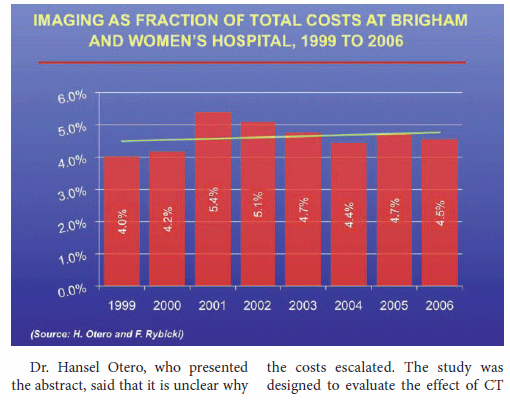Data downplay CT's rolein rising pneumonia costs
Imaging critics often point to rising CT use as a cause of increased hospitalcosts, but a new study finds CT is notto blame, at least not when used toimage patients with pneumonia.
Imaging critics often point to rising CT use as a cause of increased hospital costs, but a new study finds CT is not to blame, at least not when used to image patients with pneumonia.
The average number of CT studies performed at Brigham and Women's Hospital in Boston increased 50% from 1999 to 2006, but CT represented only one-third of all imaging costs. Although imaging costs shot up from $475 per patient in 1999 to $726 in 2006, the percentage of hospital costs from pneumonia remained fairly constant, with a variation of less than 1%, averaging $20,505, according to the researchers.
Michael Lu, Ph.D., a research fellow at Brigham and Women's, and colleagues retrospectively examined 1064 patients with a primary diagnosis of pneumonia from 1999 to 2006. The researchers retrieved information from hospital accounting and administration data.
Hospital and imaging costs have significantly increased, but the fraction represented by imaging has remained constant, which suggests imaging is unlikely to be the reason for the cost increase, the researchers said during a scientific session at the 2008 RSNA meeting.

Dr. Hansel Otero, who presented the abstract, said that it is unclear why the costs escalated. The study was designed to evaluate the effect of CT and other imaging modalities on hospital admission costs for pneumonia patients, but a specific cost-effectiveness study is needed to determine why hospital costs increased, he said.
The number of chest radiographs did not change significantly, with an average of 5.47 during the study period.
In addition, the average length of stay was 9.2 days. Approximately onethird of pneumonia patients were admitted to the ICU, and 18.7% required mechanical ventilation. The researchers found the all-cause in-hospital mortality was 11.5%.
The researchers compiled data from the hospital administration database, but detailed information was left out, which limited the conclusions the researchers could make, Otero said.
GE HealthCare Debuts AI-Powered Cardiac CT Device at ACC Conference
April 1st 2025Featuring enhanced low-dose image quality with motion-free images, the Revolution Vibe CT system reportedly facilitates improved diagnostic clarity for patients with conditions ranging from in-stent restenosis to atrial fibrillation.
The Reading Room Podcast: Current Perspectives on the Updated Appropriate Use Criteria for Brain PET
March 18th 2025In a new podcast, Satoshi Minoshima, M.D., Ph.D., and James Williams, Ph.D., share their insights on the recently updated appropriate use criteria for amyloid PET and tau PET in patients with mild cognitive impairment.